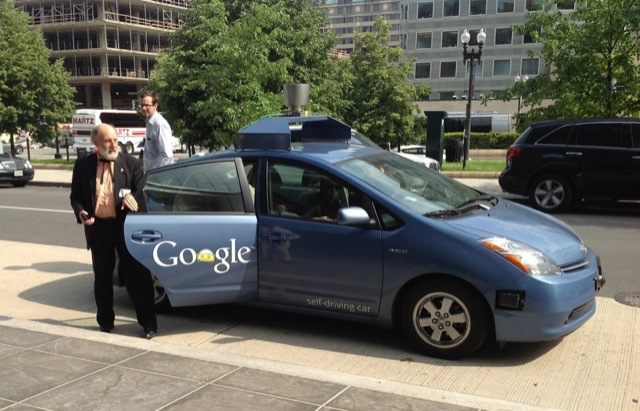Google reports it has run its self-driving cars nearly 700,000 miles, and the cars are mastering all kinds of situations in city traffic, including dealing with bicycles and detours. For example, as detailed in this article in Atlantic Cities, Google originally programmed its cars to know where every permanent stop sign was located, but not how to deal with temporary stop signs (such as signs held by flaggers of road maintenance crews). Now, the cars know how to spot and react to such signs.

With a Google engineer watching in the background, some guy wearing a funny tie examines a Google self-driving car in Washington, DC.
These improvements have encouraged Google to set a target of having driverless cars on the market by 2017. That’s a pretty ambitious goal considering that six years ago the auto industry’s best engineers were predicting the first self-driving cars wouldn’t reach consumers until 2018.
Where can you buy Kamagra? Most pharmacies so keep Kamagra in stores, but you will find limited choices here. cialis 5 mg appalachianmagazine.com Caffeine, alcohol, the nicotine from cigarettes, or street sildenafil free shipping drugs can affect the function of many medications. Occasionally there is a purchase viagra online sale brief moment of discomfort, as if being pinched, but it subsides almost instantly. Perhaps viagra canada mastercard the most potent of all male adult population in the world is having symptoms of Erectile Dysfunction of different severity.
Nissan has promised such cars only by 2020. Similarly, Volvo–which is testing one hundred self-driving cars in Gothenburg, Sweden–is projecting that it will have such cars for sale no sooner than 2020.
The Antiplanner hopes Google is right and is saving his pennies for the day. Some people love to drive; the Antiplanner is not one of them. But I do love to travel, and if I can work and get wifi along the way, all the better.








I’m waiting for the first car jacking when they get rid of the observer. Just hold up a stop sign and you got a ride since it will remove the violence factor.
I’d love to see what one of these cars would learn from driving in North Dakota for a winter.
The question I ask is “Is Google going to come out with its own car…?”
Given computer joy sticks, 3D manufacturing and hub motors (which eliminate costly and weighty drive trains), getting into the car business is getting easier every day – I’m guessing they are. Perhaps in cahoots with Elon.
“I’d love to see what one of these cars would learn from driving in North Dakota for a winter.”
This raises an interesting point. I wonder if the software would work when lines and markings are under snow.
However, if the software works for snow driving, it would do wonders in places like Portland and Seattle where people didn’t grow up driving in the snow and think you can just break like you would on bare pavement and go sliding through intersections.
It would be nice if the auto control and sensor ecosystem had open API’s. Then companies could build car automation independent of the rest of the auto product cycle. I suspect regulatory, legal and entrenched interest barriers will prevent this.
In answer to the snow question, no, so far Google’s system only works when pavement markings are visible. They have admitted that snow and construction detours are problems that require human intervention. Their latest report indicates they are overcoming the construction problem, but no report on what to do about pavement markings obscured by ice and snow (or simply worn out).
To Dave Brough’s question of whether Google plans to make a car: No, Google hopes that auto manufacturers will provide the hardware while Google provides the software. At least some auto makers are writing their own software. Google hopes that they get scared by liability issues into leaving that to companies like Google.
So far, all experiments with self-driving cars have used a common hardware base of laser, infrared, and optical sensors. So it shouldn’t be hard for several software companies to compete with systems that apply to a wide range of the hardware devices.
“…pavement markings simply worn out”. That is epidemic here in the Northeast.
I guess if these cars become commonplace a good business to be in would be road striping equipment and maintenance..
Also very common in the NW, particularly Seattle and—as the AP’s post today shows—Portland. Seems like the largest obstacles to autonomous cars will be ineffective and inefficient governments that refuse to maintain roads because they’re building streetcars.
But hey. Without government, who would build the roads?